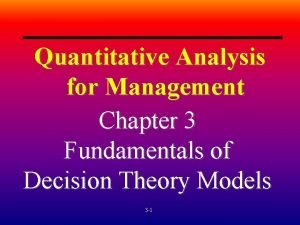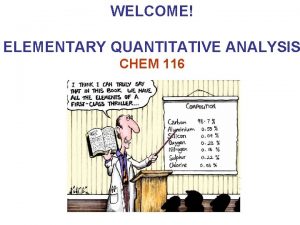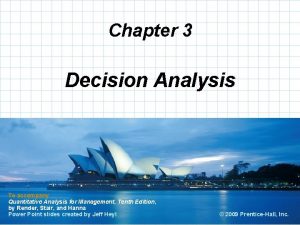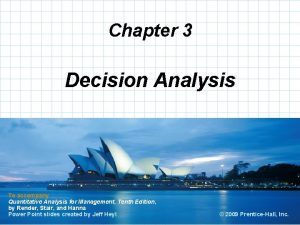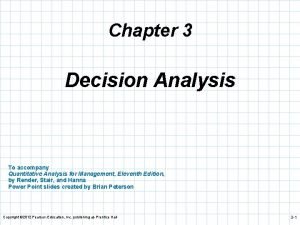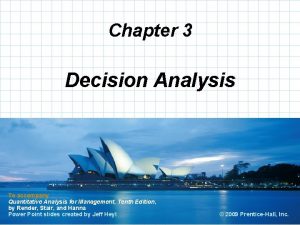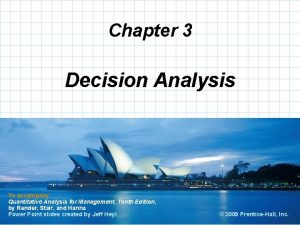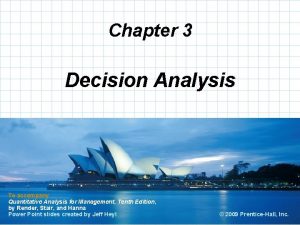Chapter 3 Decision Analysis To accompany Quantitative Analysis








- Slides: 8

Chapter 3 Decision Analysis To accompany Quantitative Analysis for Management, Eleventh Edition, by Render, Stair, and Hanna Power Point slides created by Brian Peterson

Learning Objectives After completing this chapter, students will be able to: 1. List the steps of the decision-making process. 2. Describe the types of decision-making environments. 3. Make decisions under uncertainty. 4. Use probability values to make decisions under risk. Copyright © 2012 Pearson Education, Inc. publishing as Prentice Hall 3 -2

Introduction n What is involved in making a good decision? n Decision theory is an analytic and systematic approach to the study of decision making. n A good decision is one that is based on logic, considers all available data and possible alternatives, and the quantitative approach described here. Copyright © 2012 Pearson Education, Inc. publishing as Prentice Hall 3 -3

The Six Steps in Decision Making 1. 2. 3. 4. 5. 6. Clearly define the problem at hand. List the possible alternatives. Identify the possible outcomes or states of nature. List the payoff (typically profit) of each combination of alternatives and outcomes. Select one of the mathematical decision theory models. Apply the model and make your decision. Copyright © 2012 Pearson Education, Inc. publishing as Prentice Hall 3 -4

Types of Decision-Making Environments Type 1: Decision making under certainty n The decision maker knows with certainty the consequences of every alternative or decision choice. Type 2: Decision making under uncertainty n The decision maker does not know the probabilities of the various outcomes. Type 3: Decision making under risk n The decision maker knows thprobabilities of the various outcomes. Copyright © 2012 Pearson Education, Inc. publishing as Prentice Hall 3 -5

Decision Making Under Uncertainty There are several criteria for making decisions under uncertainty: 1. Maximax (optimistic) 2. Maximin (pessimistic) 3. Criterion of realism (Hurwicz) 4. Equally likely (Laplace) 5. Minimax regret Copyright © 2012 Pearson Education, Inc. publishing as Prentice Hall 3 -6

Decision Making Under Risk n This is decision making when there are several possible states of nature, and the probabilities associated with each possible state are known. n The most popular method is to choose the alternative with the highest expected monetary value (EMV). n This is very similar to the expected value calculated in the last chapter. EMV (alternative i) = (payoff of first state of nature) x (probability of first state of nature) + (payoff of second state of nature) x (probability of second state of nature) + … + (payoff of last state of nature) x (probability of last state of nature) Copyright © 2012 Pearson Education, Inc. publishing as Prentice Hall 3 -7

Copyright All rights reserved. No part of this publication may be reproduced, stored in a retrieval system, or transmitted, in any form or by any means, electronic, mechanical, photocopying, recording, or otherwise, without the prior written permission of the publisher. Printed in the United States of America. Copyright © 2012 Pearson Education, Inc. publishing as Prentice Hall 3 -8
 Accompany chapter 1
Accompany chapter 1 Objectives of decision making
Objectives of decision making Investment decision financing decision dividend decision
Investment decision financing decision dividend decision Things that belong to salvation
Things that belong to salvation Cephalic vein in hand
Cephalic vein in hand Printers create objects such as prototypes and models.
Printers create objects such as prototypes and models. Quantitative analysis for management chapter 3 answers
Quantitative analysis for management chapter 3 answers Decision table and decision tree examples
Decision table and decision tree examples Quantitative analysis definition
Quantitative analysis definition






